Halicarnassus (Bodrum)
Q5843680Halicarnassus (Greek Ἁλικαρνασσός): Greek-Carian city, modern Bodrum in southwestern Turkey.
Origin
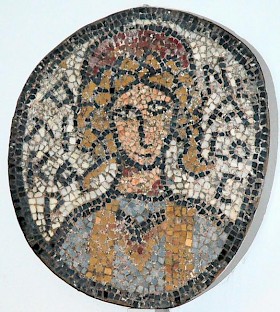
In the year 26 CE, the inhabitants of the Roman province Asia wanted to build a temple for the emperor Tiberius. The historian Tacitus tells that when the representatives of several towns were arguing that their city offered the best location, the embassy from Halicarnassus declared that in their city, the temple could be built on a rock that had been solid for twelve hundred years.note It is obvious that the embassadors believed that their town was founded in about 1175 BCE, seventeen years after the legendary Trojan War.
This argument failed to convince the senators who were to decide about the location. One reason may, perhaps, have been that the claim was implausible. Most legends told that Halicarnassus was founded by Dorians from the Peloponnese, and these legends also told that this tribe had conquered the Peloponnese eighty years after the fall of Troy. The Halicarnassians were clearly overstating the antiquity of their city.
Yet, their town was very, very old indeed. It may go back to the late eleventh or early tenth century, when many Greeks left their homeland and settled on the coast of Asia Minor (the Ionian migration). The leader of the colonists may have been a man named Anthes of Troezen. The native Carians, or Leleges, were either expelled or appeased with a treaty. Usually, the two groups went along pretty well and there is evidence for both intermarriage and religious fusion. Nevertheless, the ethnic opposition was still recognizable in the fourth century BCE.
Archaic Age
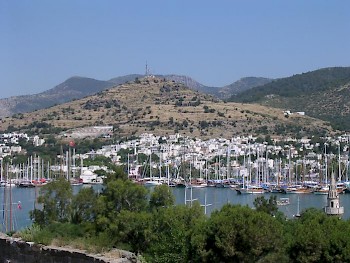
Usually, Greek settlers first occupied an island near a native settlement; later, they settled on the mainland. We may assume that the first Greeks built their houses on the island that was later known as the Royal Island. Today, it is no longer an island, but an impressive castle built in the age of the Crusades. The native settlement probably was at the Salmacis hill, which was crowned by a sanctuary of Hermaphroditus. It will not be easy to excavate this part, because it is partly overbuilt with modern houses, and partly occupied by a military base.
Later, the Greeks settled on the mainland. To the northeast of the island, they founded a marketplace to trade with the natives. (Today, this is the entertainment district of Bodrum.) The new Greek settlement itself was to the northwest. When the Halicarnassians had to trade something between themselves, they did so on the agora, which was close to harbor. The residential quarters were built on terraces above the agora; later observers compared the town to a theater, in which the harbor between the Salmacis hill and the Royal island was the dance floor. Reportedly, traces of an early city wall have been discovered to the northeast of the fourth-century walls that are still visible today. The remains of the temple of Athena were found in modern Konacik, along the road from Bodrum to the west.
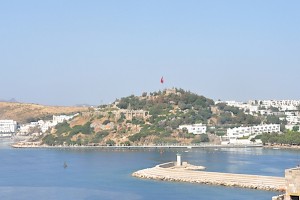
The Greeks thought that Halicarnassus was a "Dorian" city: its first settlers were from the Peloponnese and belonged to this tribe. The city was really proud of this descent, but in fact, the Dorian nature of the population was soon forgotten. The inhabitants spoke the Ionian dialect. In fact, the Histories by Halicarnassus' most famous son Herodotus (c.480-c.429) are one of the most important sources for our understanding of Ionian Greek.
Persian Age
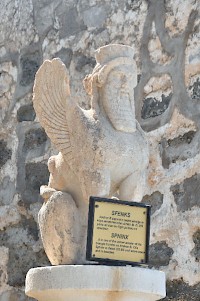
The mixed Graeco-Carian city probably was part of the Lydian empire of king Croesus (mid-sixth-century). When he had been defeated by Cyrus the Great, the Persian general Harpagus mopped up the last centers of resistance. Halicarnassus now became part of the empire of the Persian Achaemenids, who preferred one man as ruler of this city: Lygdamis. He was succeeded by his daughter Artemisia, the commander of a naval squadron during the Greek campaign of the Persian king Xerxes (480 BCE). She was not the last female general from Halicarnassus.
As it turned out, Xerxes was unable to overcome the Greeks, and Greece remained independent. Athens continued the war against Persia and organized its allies in the Delian League. In 469, the grandson of Artemisia, Lygdamis II, joined this league as an independent ruler. For reasons that are unknown to us, several Halicarnassians organized a revolt against their ruler, but he was able to maintain his position. Among those sent into exile is said to have been Herodotus, who became the world's first historian.
There is an interesting inscription from this age. It records a law on property and mentions both Lygdamis and the citizens as joint rulers. More importantly, it mentions Salmacis as a more or less independent community. This suggests that Greeks and Carians were still recognizable as separate ethnic groups.
The Hecatomnids
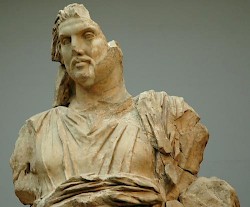
By the end of the Peloponnesian War (in any case after 412), Halicarnassus had lost its independence and was part of the Persian Empire again. It belonged to the satrapy of Caria, which was ruled by a local dynast called Hecatomnus of Mylasa (391-377), and later by his son Maussolus (377-353). They are called the Hecatomnid Dynasty.
When he became sole ruler, the Achaemenid Epire was in decline, but Maussolus remained loyal. For instance, he fought for the great king against Ariobarzanes, a rebel satrap in the northwest of modern Turkey (365). In these years, he rebuilt Halicarnassus, which became his capital.
The city, built on a gridiron plan, received many new inhabitants and was fortified with modern walls, which were designed to ward off attacks by the recently invented catapults. Large parts of the wall, which was 6 kilometers long, are still visible. Other buildings that may have been planned by Maussolus (even when their actual construction took place later) are the theater and the temple of the war god Ares.
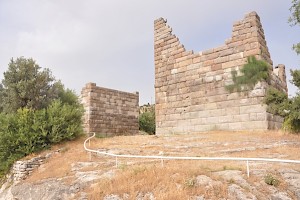
Almost immediately after the war against Ariobarzanes, Maussolus took part in the Revolt of the Satraps: Orontes of Armenia, Autophradates of Lydia and Datames of northern Turkey joined forces with Maussolus against their king, with support of the pharaoh of Egypt. Although the rebels were defeated, King Artaxerxes III Ochus had to reinstall Maussolus as satrap of Caria. Even though the Persians retained a garrison at Halicarnassus, Maussolus had in fact become independent. Several ancient sources call him "king", which explains why the island in the harbor, where his palace was built, is called "royal island".
Maussolus died in 353. He was succeeded by his sister Artemisia, who built a famous monument for her brother: the Mausoleum, in the center of the town. The monument served essentially to give legitimization to the new queen, and was later regarded as one of the seven wonders of the ancient world. Several Greek artists were active in Halicarnassus, a.o. Scopas.
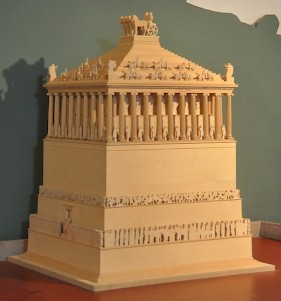
Meanwhile, the Rhodians had decided to conquer Halicarnassus. However, from her palace on the Royal island Artemisia noticed that they had occupied the eastern harbor, where they could not see what happened in the western harbor. In a lightning raid, she was able to surprise and defeat them. Her rule was now unchallenged, but she died within two years.
Hellenism
In the 340s, the members of the royal family were quarreling, and some of them were pro-Persian, whereas others were pro-Macedonian. When Alexander the Great approached Caria in 334, Halicarnassus was one of the most important Persian strongholds, defended by the Greek mercenary leader Memnon of Rhodes, and the Macedonian invaders of Asia came very close to defeat. However, a discontent member of the royal family, Ada, sided with Alexander, which gave him sufficient support in Caria to continue the siege.
After the death of Alexander in Babylon (11 June 323), Caria and its capital were contested by his Successors. Halicarnassus was first ruled by Antigonus Monophthalmus; was part of the empire of Lysimachus in 301; and later became a province op the Ptolemaic Empire; only to change into Seleucid hands before the mid-third century. However, when war broke out between king Antiochus III the Great and the Roman republic, Halicarnassus was able to pursue a pro-Roman policy.
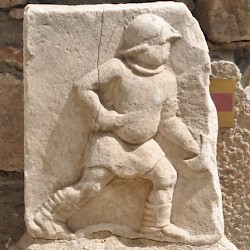 Halicarnassus, Relief of a gladiator |
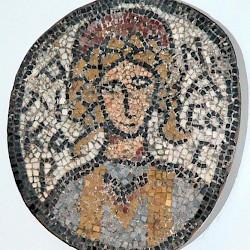 Halicarnassus, Mosaic of the city goddess |
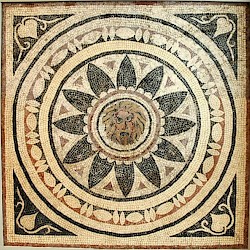 Halicarnassus, Mosaic of Phobos |
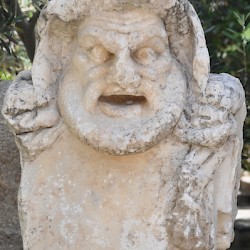 Halicarnassus, Theater mask |
Roman age
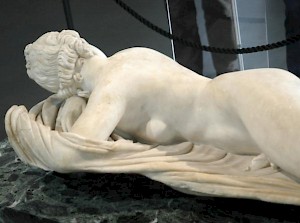
Although independent, the city now belonged to the Roman world, and in the early first century BCE, it became a natural target for Rome's enemy Mithridates VI Eupator of Pontus, and for the Cilician pirates. In 58, the city was annexed and became part of the province of Asia. During the civil wars, it sympathized with Julius Caesar and followed his kind policy towards the Jews (a well-known text of a decree survives; quoted here).
The Romans remembered Halicarnassus especially because of a myth retold by their poet Ovid: this was the place where the water nymph Salmacis had fallen in love with Hermaphroditus. The two had become one, bisexual being. Roman Halicarnassus boasted a sanctuary for this hermaphrodyte. (The well that had once been inhabited by the water nymph is still there, a nice place to swim.)
As we already noticed at the beginning of this article, the Halicarnassians showed their loyalty by their intention to dedicate a temple to the emperor. Little is known about its later history, although the town remained inhabited and was to become part of the Byzantine Empire.